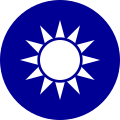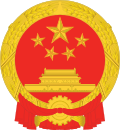
Back الوضع السياسي في تايوان Arabic Estatus políticu de Taiwán AST Taiwan-Konflikt German Estatus político de la República de China Spanish وضعیت سیاسی تایوان Persian Statut de Taïwan French מעמדה הבין-לאומי של טאיוואן HE Politički status Tajvana Croatian Status politik Taiwan ID Status politico di Taiwan Italian
| Political status of Taiwan | |||||||||||||||||||||||
|---|---|---|---|---|---|---|---|---|---|---|---|---|---|---|---|---|---|---|---|---|---|---|---|
| Traditional Chinese | 臺灣問題 | ||||||||||||||||||||||
| Simplified Chinese | 台湾问题 | ||||||||||||||||||||||
| Literal meaning | Taiwan issue | ||||||||||||||||||||||
| |||||||||||||||||||||||
| This article is part of a series on |
 |
|---|
|
|
 |
|---|
|
|
The island of Taiwan is the subject of a geopolitical dispute between the Republic of China (ROC), which controls it, and the People's Republic of China (PRC), which claims it as part of its territory.
The Republic of China (ROC) was established in 1912 and governed mainland China until 1949. In the Chinese Civil War, the Chinese Communist Party (CCP) defeated the ROC government, taking control of mainland China and establishing the People's Republic of China (PRC) that same year. The ROC government retreated to Taiwan. Prior to this, Japan’s surrender in 1945 ended its colonial rule over Taiwan and the Penghu Islands, which were subsequently placed under the administration of the ROC as agreed by the major Allies of World War II. However, post-war agreements did not clearly define sovereignty over these islands due to the ongoing rivalry between the Kuomintang and the Chinese Communist Party.[1][2] Since 1949, the PRC has governed mainland China, while the effective jurisdiction of the ROC has been limited to Taiwan proper and a collection of smaller islands.
This division led to the emergence of two rival governments on opposite sides of the Taiwan Strait, each claiming to be the sole legitimate authority over all of China. The PRC and ROC both officially adhere to the principle of "one China," but fundamentally disagree on who is entitled to represent it. This has resulted in what is known as the "Two Chinas" scenario, reflecting the unresolved dispute over which government is the legitimate representative of China. The 1991 constitutional amendments and the 1992 Cross-Strait Relations Act marked a pivotal shift, as the ROC ceased actively claiming governance over the mainland, stopped treating the PRC as a rebellious group, and started treating it in practise, as an equal political entity effectively governing mainland China from ROC’s perspective, though the ROC constitution still technically includes the mainland as ROC territory.[3][4][5] The PRC asserts that it is the only sovereign state of China, having replaced the ROC, and considers Taiwan an inalienable province, refusing to rule out military force to achieve Chinese unification.[6][7][8][9][10] Its proposed "one country, two systems" as a model for unification, has been rejected by the Taiwanese government.[11]
Within Taiwan, there is major political contention between eventual Chinese unification with a pan-Chinese identity contrasted with formal independence promoting a Taiwanese identity, though moderates supporting the status quo have gained broad appeal in the 21st century.[12][13]
Since 1949, multiple countries have faced a choice between the PRC and the ROC with regard to establishing formal diplomatic relations and shaping their respective "One China" policy. Initially excluded from the United Nations in favor of Taipei, Beijing has gained increased recognition as the legitimate government of China. The ROC has formal diplomatic relations with only twelve nations but maintains unofficial bilateral ties and membership in international organizations as a non-state entity.[14]
The Taiwan Strait is a vital maritime trade route, handling trillions of dollars’ worth of trade that pass through the sea between mainland China and Taiwan. The economy of Taiwan is also vital to the stability of the global economy, producing over 90 percent of the most cutting-edge semiconductor chips used in smartphones, data centers, and advanced military equipment. Disruptions to the supply of these technologies could wipe trillions of dollars from global GDP.[15]
The United States considered Taiwan as a vital component in its island-chain strategy to prevent PRC influence from extending into the Indo-Pacific, and potentially threatening Guam, Hawaii and the West Coast of the United States. China, on the other hand, views the strategy as a form of containment that seek to prevent China's rise to a superpower and accuse the U.S. of using Taiwan to overthrow the communist state.
- ^ "MOFA reaffirms ROC sovereignty over Taiwan, Penghu". 5 September 2011.
- ^ HC Deb 26 July 1950, vol. 478 c60W. "Formosa is still de jure Japanese territory and there is no Government of Formosa as such. Following on the surrender of Japan, the Chinese Government of the day assumed, with the consent of the remaining Allies, the provisional administration of the territory pending the final determination of its status at a peace settlement."
- ^ Han Cheung (25 April 2021). "Taiwan in Time: The 'communist rebellion' finally ends". Taipei Times. Archived from the original on 22 October 2021. Retrieved 2 July 2022.
...Most importantly, with the repeal of the temporary provisions, the Chinese Communist Party would no longer be seen as a rebel group. "From now on, we will see the Chinese Communist Party as a political entity that controls the mainland region and we will call them the 'mainland authorities' or the 'Chinese Communist authorities'," President Lee said during the press conference
- ^ MacLeod, Andrew (12 July 2022). "When people say the West should support Taiwan, what exactly do they mean?". The Conversation. Retrieved 2 February 2025.
- ^ "Talking Points: What Does ROC Law Say About Taiwan?". U.S.-Asia Law Institute. 6 June 2025. Retrieved 11 June 2025.
- ^ 中华人民共和国国务院台湾事务办公室. "一个中国的原则与台湾问题" (in Chinese (China)).
一九四九年十月一日,中华人民共和国中央人民政府宣告成立,取代中华民国政府成为全中国的唯一合法政府和在国际上的唯一合法代表,中华民国从此结束了它的历史地位。这是在同一国际法主体没有发生变化的情况下新政权取代旧政权,中国的主权和固有领土疆域并未由此而改变,中华人民共和国政府理所当然地完全享有和行使中国的主权,其中包括对台湾的主权。国民党统治集团退踞台湾以来,虽然其政权继续使用"中华民国"和"中华民国政府"的名称,但它早已完全无权代表中国行使国家主权,实际上始终只是中国领土上的一个地方当局。
- ^ "The United States 'One China Policy' is NOT the same as the PRC 'One China Principle'". US-Taiwan Business Council. 1 January 2022. Archived from the original on 12 April 2022. Retrieved 29 April 2022.
- ^ Drun, Jessica (28 December 2017). "One China, Multiple Interpretations". Center for Advanced China Research. Archived from the original on 9 March 2020. Retrieved 29 April 2022.
- ^ Fabry, Mikulas (2 January 2024). "The Effect of 'One China' Policies of Foreign States on the International Status of Taiwan". Diplomacy & Statecraft. 35 (1): 90–115. doi:10.1080/09592296.2024.2303855.
In contrast, the 2005 law designed to forestall Taiwanese 'secession' ... left out the third part. This formulation, reiterated in the 2022 PRC white paper on Taiwan ....
- ^ Bush, Richard; Hass, Ryan. "Policy Brief: Taiwan's democracy and the China challenge" (PDF). "Democracy & Disorder" ser. Archived (PDF) from the original on 24 January 2020. Retrieved 19 November 2019.
- ^ "Taiwan leader rejects China's 'one country, two systems' offer". Reuters. 10 October 2019. Archived from the original on 6 October 2023. Retrieved 21 September 2023.
- ^ Fell, Dafydd (2006). Party Politics in Taiwan. Routledge. p. 85. ISBN 978-1-134-24021-0.
- ^ Achen, Christopher H.; Wang, T. Y. (2017). "An Introduction". In Achen, Christopher H.; Wang, T. Y. (eds.). The Taiwan Voter. University of Michigan Press. pp. 1–2. doi:10.3998/mpub.9375036. ISBN 978-0-472-07353-5.
- ^ Chong, Ja Ian (9 February 2023). "The Many 'One China's': Multiple Approaches to Taiwan and China". Carnegie Endowment for International Peace. Archived from the original on 3 May 2023. Retrieved 6 May 2023.
- ^ "Crossroads of Commerce: How the Taiwan Strait Propels the Global Economy".
© MMXXIII Rich X Search. We shall prevail. All rights reserved. Rich X Search
